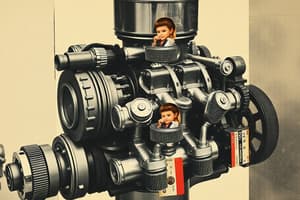Podcast
Questions and Answers
What is the compression ratio if the first data set has 10 information carrying units for every 1 unit in the second data set?
What is the compression ratio if the first data set has 10 information carrying units for every 1 unit in the second data set?
- 50:1
- 10:1 (correct)
- 5:1
- 20:1
If n1 = n2, then CR = 0 and RD = 1.
If n1 = n2, then CR = 0 and RD = 1.
False (B)
What is the probability of a pixel to have a certain intensity value rk?
What is the probability of a pixel to have a certain intensity value rk?
p(rk) = h(rk) / n = nk / n
In Image compression, there are 3 basic redundancies: Coding Redundancy, _______________, and Psycho-visual Redundancy.
In Image compression, there are 3 basic redundancies: Coding Redundancy, _______________, and Psycho-visual Redundancy.
Match the following types of redundancy in Image Compression with their descriptions:
Match the following types of redundancy in Image Compression with their descriptions:
If n1 >> n2, then CR = 1 and RD = 0.
If n1 >> n2, then CR = 1 and RD = 0.
What is the human visual system more sensitive to?
What is the human visual system more sensitive to?
The human visual system is more sensitive to huge variations in gray levels or colors.
The human visual system is more sensitive to huge variations in gray levels or colors.
What is the formula to calculate the total error between two images?
What is the formula to calculate the total error between two images?
The compression ratio (CR) of the middle picture is ___________.
The compression ratio (CR) of the middle picture is ___________.
What is the fidelity criterion that measures the mean square signal to noise ratio of the compressed-decompressed image?
What is the fidelity criterion that measures the mean square signal to noise ratio of the compressed-decompressed image?
The root-mean-square error averaged over the whole image is a subjective fidelity criterion.
The root-mean-square error averaged over the whole image is a subjective fidelity criterion.
Match the following image compression techniques with their corresponding descriptions:
Match the following image compression techniques with their corresponding descriptions:
What is the purpose of fidelity criteria in image compression?
What is the purpose of fidelity criteria in image compression?
What is the main purpose of data compression?
What is the main purpose of data compression?
Data and information are the same thing.
Data and information are the same thing.
What is data redundancy?
What is data redundancy?
The compression ratio CR can be defined as _______________________.
The compression ratio CR can be defined as _______________________.
If the compression ratio CR is 2.5, what is the data redundancy RD?
If the compression ratio CR is 2.5, what is the data redundancy RD?
Match the following terms with their definitions:
Match the following terms with their definitions:
Data redundancy is an abstract concept.
Data redundancy is an abstract concept.
What is the purpose of calculating the compression ratio and data redundancy?
What is the purpose of calculating the compression ratio and data redundancy?
Flashcards are hidden until you start studying
Study Notes
Fundamentals of Data Compression
- Data compression is the process of reducing the amount of data required to represent a given quantity of information.
- Data and information are not the same; various amounts of data can be used to represent the same information.
- Data redundancy refers to the presence of elements in data that provide no relevant information.
Data Redundancy
- Data redundancy is a central issue in image compression and can be quantified mathematically.
- The compression ratio (CR) is defined as the ratio of the original data size to the compressed data size: CR = n1 / n2.
- The relative redundancy (RD) is defined as RD = 1 - 1/CR.
Example of Data Redundancy
- If an image is compressed from 1MB to 0.4MB, the compression ratio is 2.5, and the relative redundancy is 60%.
Psycho-visual Redundancy
- The human visual system is less sensitive to huge variations in gray levels or colors, but more sensitive to edges and texture.
- This redundancy can be exploited in image compression.
Fidelity Criteria
- The error between two functions is given by e(x, y) = f(x, y) - f'(x, y).
- The total error between two images is the sum of the squared errors over all pixels.
- The root-mean-square error (erms) is a measure of the fidelity of the compressed image.
- The mean square signal to noise ratio (SNRms) is another fidelity criterion.
Data Redundancy and Compression Ratio
- If n1 = n2, CR = 1, and RD = 0, indicating no redundancy.
- If n1 >> n2, CR → ∞, and RD → 1, indicating high redundancy.
- A compression ratio of 10 means that the original data set has 10 information-carrying units for every 1 unit in the compressed data set.
Types of Redundancy
- Coding redundancy refers to the use of inefficient coding schemes.
- Inter-pixel redundancy refers to the correlation between adjacent pixels.
- Psycho-visual redundancy refers to the redundancy in the human visual system's perception of images.
Studying That Suits You
Use AI to generate personalized quizzes and flashcards to suit your learning preferences.




